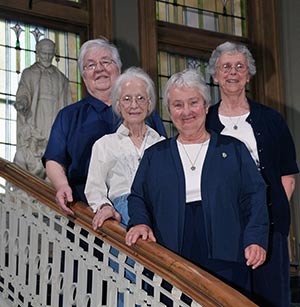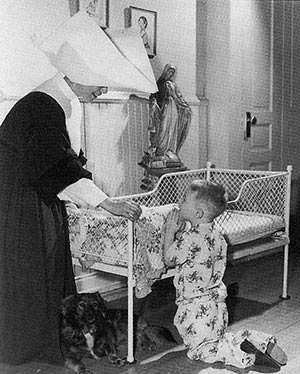
Over the years, gatherings to welcome and bid farewell have been common at the Lake Drive house on Milwaukee’s east side, home for the Daughters of Charity of St. Vincent de Paul. Sisters arrived for their “missionings” at local hospitals, schools or prisons, and after a period of time they moved into ministries at other locations.
Standing on the stairs of the historic and former St. Mary’s Hospital in Milwaukee, on Tuesday, July 31 are, left to right, Daughters of Charity Srs. Mary Kay Tyrell, Angele Hinkey, Jean Maher and Mary Elizabeth Cullen. (Catholic Herald photo by Ernie Mastroianni)
“You feel you are called to each place,” said Sr. Jean Maher, a Daughter of Charity. She and three sisters live in the home now, but they are packing and emptying the residence as they prepare to leave on Aug. 20 – the same date the first Sisters of Charity arrived in Milwaukee in 1846.
Sr. Louise Gallahue, the visitatrix for the Daughters of Charity St. Louis Province, cited the decrease in the province’s number of sisters available to staff ministries as the major factor in the decision to have the Daughters leave Milwaukee.
The Daughters’ reassignments also follow their constitution and national trend in their ministry to consolidate where there is the greatest need.
Sr. Louise added that with the archdiocese strongly committed to Catholic leadership, including dedicated laity and the other Catholic religious sisters, the Daughters take comfort in knowing that service to Milwaukee’s poor will continue.
“We are a new province with a broad territorial area and we are studying where our presence will be needed,” said Sr. Louise.
About 540 Daughters of Charity are members of the province, based in St. Louis, established last year when four provinces were unified. Throughout the world, about 17,000 Daughters of Charity live in more than 90 countries.
Archbishop expresses gratitude
In a letter written in June to Sr. Louise, Archbishop Jerome E. Listecki expressed gratitude for the Daughters’ long history of service, writing, “We will feel a little bit incomplete without your presence. However, we know your presence will be with us in simply a different way – through your prayers of ongoing support and in the spirit of those many dedicated women who came before.”
In total, 364 Daughters of Charity have arrived in Milwaukee throughout the past 166 years to share their love of God and to care for the disadvantaged.
In their first decades here, the sisters nursed immigrants on a “plague ship,” they tended to the poor, sick and injured, including returning Civil War soldiers, and they helped the hundreds left homeless after the 1892 Third Ward Fire.

The sisters’ work evolved in response to the community’s needs, from teaching children to starting hospitals, orphanages, group homes and community clinics. Their dress in the past included a distinctive, white, winged cornette, but today Daughters wear a simple skirt and blouse; a veil is optional.
Current Daughters
Srs. Mary Elizabeth Cullen, Angele Hinkey, Jean Maher and Mary Kay Tyrell will be the last Daughters of Charity in the Lake Drive residence. Each expressed deep fondness for the Milwaukee community.
“Although we’ll miss the people here, through their work, we know the ministries will continue heartily,” said Sr. Mary Kay, who has been at Columbia St. Mary’s Hospital Ozaukee as the community liaison for outreach. She will move to Indianapolis to work at St. Vincent Hospital.
Sr. Angele came to Milwaukee about six years ago. She has been facilitating oil painting experiences for women at the Milwaukee Secure Detention Facility. In her move to Chicago, she hopes to continue that work with women in the Cook County Department of Corrections.
Sr. Jean, who grew up in Milwaukee, returned to her hometown in February and has been teaching English to adults at the International Learning Center. Her new home will be in Nashville, Tenn., where she will minister to the homeless.
Sr. Mary Elizabeth serves on the Columbia St. Mary’s Foundation Board, and added that the Daughters of Charity will remain involved in the governance of Columbia St. Mary’s. She will move to St. Louis to help at the Rehabilitation Hospital at the DePaul Health Center.
Centuries of service

A devotion to Christ and to those in need, regardless of one’s creed, race or nation, defines the Daughters of Charity’s way of life; they make a vow of service to the poor, along with vows of poverty, chastity and obedience.
The Daughters of Charity established St. Vincent’s Infant Asylum on Milwaukee’s south side in 1877 housing infants and children under 5, as seen in this circa 1950s photo. (Submitted photos courtesy Daughters of Charity)
Founded in 1633 by St. Louise de Marillac and St. Vincent de Paul, the Daughters of Charity were among the first community of sisters who were not cloistered. St. Vincent instructed them to have “as a convent, the houses of the sick; as a cell, a rented room; as a chapel, the parish church; as a cloister, the streets of the city and the halls of the hospitals.”
Living among the poor to serve those most neglected was radical in the 1600s, and this approach to ministering has shaped their work for centuries.
Inspired by the work of the original Daughters, St. Elizabeth Ann Seton founded a community in Emmitsburg, Md., called the Sisters of Charity, which joined with the Daughters of Charity, headquartered in Paris, in 1850.
Daughters meet Milwaukee’s needs
In Milwaukee during the 1840s, the city’s quickly growing population included thousands of immigrants, many of them destitute. Rates of disease increased due to the insufficient housing and sewage system. Wanting to respond to the community’s urgent needs, Bishop John Martin Henni contacted the Sisters of Charity in Emmitsburg in 1845, asking if sisters could be sent to the recently formed diocese to teach; he also noted that Milwaukee would soon need a hospital and orphanages.
The first three sisters arrived in 1846 and taught girls at St. Peter Church, launching the parochial school system in Milwaukee. By 1850, 11 sisters ministered in Milwaukee. This group of women helped establish many significant institutions: the city’s first hospital in 1848, St. Rose Orphanage in 1849, and St. Vincent Infant Asylum, serving as a refuge for unwed mothers and orphaned infants, in 1877.
These contributions mark just the beginning of the sisters’ legacy in the Milwaukee Archdiocese. Their service aided numerous schools, parishes, social ministries, hospitals, orphanages and other Catholic agencies as Milwaukee developed from a frontier town into a modern city.
Milwaukee’s first hospital
The ministry most strongly identified with the Daughters of Charity in Milwaukee is health care. In 1848, the Sisters staffed and oversaw St. John’s Infirmary, which was the forerunner to St. Mary’s Hospital, now Columbia St. Mary’s.
“The mission that our sisters started with the first hospital is now grasped by many people – physicians, staff, volunteers, board members – all sharing the ministry of health care,” said Sr. Theresa Sullivan, a Daughter of Charity, who will continue to serve on the board of directors at Columbia St. Mary’s. She has held that position for about six years.
She noted that Columbia St. Mary’s sponsors many outreach programs and several community clinics, including St. Elizabeth Ann Seton Dental Clinic and St. Ben’s Clinic, to help serve the poor throughout the Milwaukee area.
Columbia St. Mary’s will continue to be part of Ascension Health as its Catholic co-sponsor.
An endowment fund through Columbia St. Mary’s Foundation has been established to help support programs that honor the legacy of the Daughters.
“There is great respect for the Daughters’ work,” said Mark Taylor, president and CEO of Columbia St. Mary’s Health System. “The Daughters of Charity came because the community needed them over 160 years ago, and now it’s our responsibility to carry on, for generations more, on behalf of our faith.”
Sr. Renee Rose, a Daughter of Charity who held a range of administrative positions with the hospital and health system from 1989 through 2001, now ministers in New Orleans but recently visited her old home on Lake Drive.
“It brought back many memories,” she said, “and whenever there is a change, there is sadness, which is a normal reaction. But I know that moving the Daughters is the right thing to do. There are fewer of us now, and we need to find the best ways to respond to needs that arise.”
